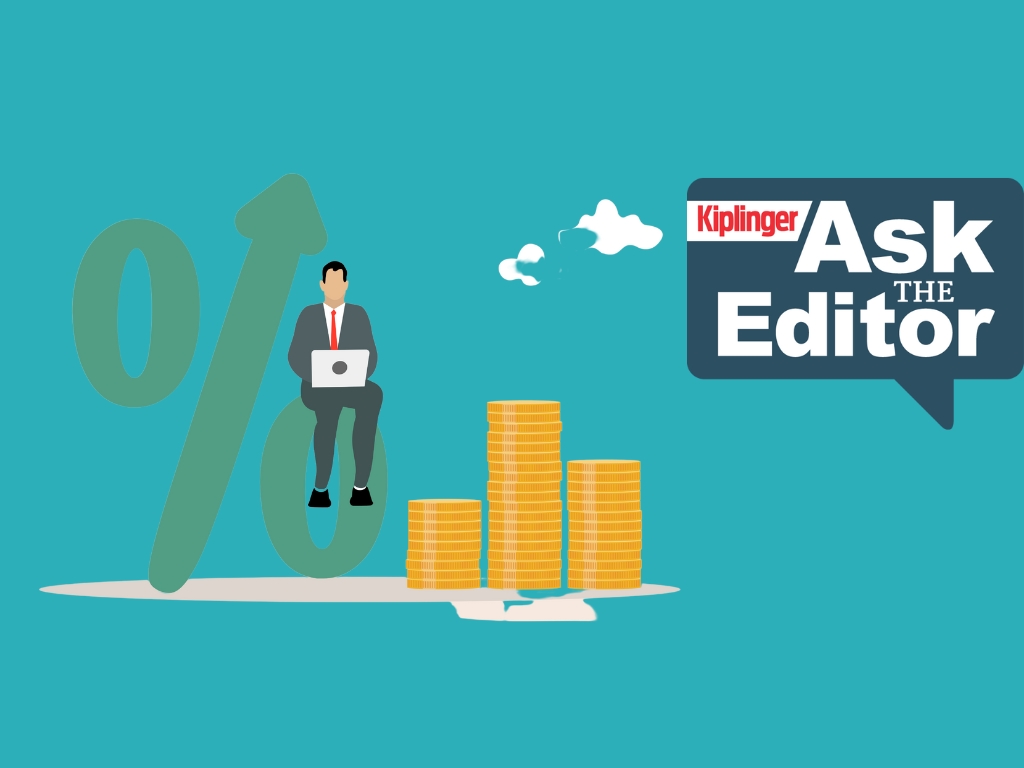PODCAST: Decoding ESG Investing with Ellen Kennedy
Environmental, social and governance investing is simpler than it sounds, and has a profitable track record to boot.

Subscribe FREE wherever you listen:
Apple Podcasts | Google Podcasts | Spotify | Overcast | RSS
Links mentioned in this episode:
- How to File Your Taxes for Free
- 7 Money-Smart Ways to Spend Your Tax Refund
- Earn 7.12% With Series I Bonds
- Amy Domini on the Secrets of Sustainable Investing
- Double Your ESG Impact With Funds Tied to Charities
- 5 'Blue Economy' Stocks and Funds
- Kiplinger ESG 20: Our Favorite Picks for ESG Investors
- EWG Skin Deep® Cosmetics Database
Transcript
David Muhlbaum: Environmental, social and governance investing is hot these days. So much so that we at Kiplinger now have our own editor on the beat. Ellen Kennedy will share her insights about the intersection of investing and activism. Also, how to spend that tax refund wisely, coming up on this episode of Your Money’s Worth.

Sign up for Kiplinger’s Free E-Newsletters
Profit and prosper with the best of expert advice on investing, taxes, retirement, personal finance and more - straight to your e-mail.
Profit and prosper with the best of expert advice - straight to your e-mail.
David Muhlbaum: Welcome to Your Money’s Worth. I’m kiplinger.com’s senior editor, David Muhlbaum, joined by my co-host, Kiplinger senior editor, Sandy Block. How are you doing, Sandy?
Sandy Block: I’m good. Finishing up my taxes right now. Did you file yours yet, David?
David Muhlbaum: Me?
Sandy Block: You said you were going to get them done this year before the deadline.
David Muhlbaum: I think it’s going to be close. I’ve roughed out a version of them. I imagine I’m going to pay what’s owed and get the extension. So at least I won’t be paying penalties for late payment. There may be domestic penalties, but I’d rather not get into that. On the bright side, I did file both of my kids’ tax returns and we, that meaning me and my kids, had a little discussion about how to claim exemption from withholding in the future, so at least someone got a little education. Actually also, I used IRS Free File so I guess I got some education too.
Sandy Block: So tax teachable moments for you and your kids. We certainly pushed IRS Free File here enough, so what did you think? What’s your review?
David Muhlbaum: You’re asking me to review software? You’re the one who reviews tax software. Well, first of all, as you know well, IRS Free File is an expression, it’s a phrase, it’s a marketing term that we and others use to get people to those filing software options that are actually free, so long as you meet the income and other requirements. IRS Free File isn’t a piece of software itself. It’s like a program. So there are many and, of those, I chose TaxSlayer. And I guess I’d say the one thing I noticed that was different from when I’ve used, shall we say, full-pay versions of TurboTax and others in the past, was that the Free File version of TaxSlayer did not offer me the ability to log into brokerage accounts and things like that to get information directly imported electronically. And that meant I had to copy and paste, sometimes even look and retype and, as we know, that’s a way to make mistakes and is tedious.
Sandy Block: Yeah, and actually TaxSlayer has gotten pretty good reviews from us, but I suspect you have to upgrade the premium to get that service, which tells us that you get what you pay for. TurboTax and H&R Block basically dropped out of Free File so the most popular tax software versions aren’t even available there anymore. So on the one hand, you get to file for free. On the other hand, you may not get all the bells and whistles you’re used to if you pay.
David Muhlbaum: Duly noted, and we should probably move on because, well, when this episode drops, it will be after that filing deadline and the only people still mucking around in software will be clowns like me who missed it. But we’re still in the tax season in a way, because now we’re in potentially the happy side of tax season, refund time.
Sandy Block: Well, refund checks or more hopefully and likely, direct deposit. And we certainly understand that this isn’t anything other than getting your own money back because you’ve given an interest-free loan to the government, but people still love their refunds. And a fat refund is probably a sign that you should consider adjusting your withholding, which you do with a W-4 if you’re an employee, but maybe that’s another-
David Muhlbaum: Yes! That’s what I went over with my kids.
Sandy Block: That’s right. Don’t give the government all your money. All right, it’s too late to do that for 2021 so let’s just talk for a minute about what to do with that fat refund. And as we’ve mentioned before, refunds are up in part because of the various stimulus programs like the enhanced child credit. While generally the goal of those was to get money out quickly, depending on how some people access them, some people didn’t really get to claim their full credit until they filed their taxes, which means a bigger refund for them.
David Muhlbaum: Okay, so I’m sure we’ve got some good solid Kiplinger eat your broccoli ideas about what you should do with that refund.
Sandy Block: We sure do, and I guess the takeaway is make your refund work for you. So I think the number one thing would be, if you’ve got any high-interest credit card debt, you want to pay that down. Interest rates are going up. The fed has pretty much put on billboards, “We are raising interest rates.” That’s going to raise the amount you��re paying on a balance on your credit card. Pay off your balance. You get a 15% return or more, you can’t get that anywhere else, so that’s number one. Build up your emergency fund is another one, and you may want to invest it because many brokerage firms will now let you open an account for less than $500 and some have no minimums at all.
David Muhlbaum: A brokerage account, or you could invest directly with Uncle Sam. You could turn that money right back around and go get you... What is the bond-
Sandy Block: The I bond.
David Muhlbaum: The I bond that’s paying 7.12%.
Sandy Block: And it’s going to go up-
David Muhlbaum: For now, for now.
Sandy Block: It’s going to go up above 9%.
David Muhlbaum: Okay, I’m going to get myself one of these. I’m going to do this as a reader service or a listener service. I’m just going to go get myself one and I’ll report back on the process.
Sandy Block: Yeah, we’ve got to talk about this.
David Muhlbaum: Yeah, okay. There are other ways that you can put that refund to use and Sandy’s delineated many more of them in... What’s it called, Sandy, the slideshow?
Sandy Block: This is a Kiplinger special. It is Seven Money-Smart Ways to Spend your Refund.
David Muhlbaum: That’s right. Do not blow it at the racetrack. Coming up next, we’ll be joined by Ellen Kennedy, Kiplinger’s editor for environmental, social and governance investing. She’ll help us decode ESG. Stick around.
Decoding ESG Investing with Ellen Kennedy
David Muhlbaum: Welcome back to Your Money’s Worth. Joining us for our main segment today is Ellen Kennedy, an associate editor for Kiplinger with a long history in the ESG space, as the jargon goes. She was an ESG manager and analyst at Calvert Investments for 15 years covering environment, climate, consumer staples, and she served on the sustainability councils of several Fortune 100 and Fortune 500 companies. She’s filed shareholder proposals on supply chain and issues like that. She served on ESG boards and councils. Real hands-on stuff. And now she’s writing for us here at Kiplinger with articles that do a great job unpacking all these acronyms we find in environmental, social and governance investing. ESG is just one of them and I think you’ll find her articles interesting, whether you’re grappling with what is this ESG stuff about really? Or maybe you’re already deep into the topic and you’d appreciate her interview with Amy Domini of Domini Impact Investments, who is a true pioneer in ESG. So welcome, Ellen.
Ellen Kennedy: Thanks for having me.
David Muhlbaum: And a welcome back also to Kyle Woodley, senior investing editor for kiplinger.com who helped bring Ellen to Kiplinger. He’ll be co-hosting with me today. Sandy Block is going to give ESG a pass.
Kyle Woodley: Hello, hello.
David Muhlbaum: So to move from who Ellen is to what she knows, I’m going to start with a definitional question. The term we’ve headlined this podcast with is ESG, environmental, social and governance investing. But let’s wade a little bit into history. When you started in this field, Ellen, it was called social investing, socially responsible investing. Can you take us back a bit please?
Kyle Woodley: Wait, did he just ask you to define the history of ESG in 30 seconds? Good luck with that.
David Muhlbaum: No, no. You’ve got a whole minute. You’ve got a whole minute.
Ellen Kennedy: Okay. Well, back in the 1980s, religious groups and human rights activists started to realize that capital markets, the stock market, are a powerful tool to bring about change. So a handful of firms, like Amy Domini’s that you just mentioned, dedicated to socially responsible investing or SRI, they set the table for a way investors could avoid industries they found distasteful or unsustainable like tobacco. And they also tried to work with these activists to pressure corporations to change. So SRI investors were asking the question, how can we use investing to maximize positive impact in the world?
David Muhlbaum: So investors, they were part of the fight against big tobacco?
Ellen Kennedy: That’s right, David. And as SRI investors became more and more successful, the mainstream investors sat up and took notice. They realized that some sustainability issues really could affect a company’s bottom line or what we call material, and so environmental, social and governance or ESG investing was born in the mid 2000s. They asked the question, how can we harness sustainable opportunity or risk to improve performance?
David Muhlbaum:
They being investors?
Ellen Kennedy: Yes, the ESG investors. Yes, so nowadays we have this huge mosaic of many, many sustainable investment approaches. ESG has two levers it can pull. If you imagine a box with two up and down vertical levers in front of you, the first one is deciding how much you want to invest to avoid risk versus seize opportunity. So all the way at the top of that lever, your ESG fund will avoid investing in the dirtiest companies. And if you pull that lever chunk like in an old voting booth, it will focus on a theme like renewable energy or investing in industry leaders.
The second lever is how much the fund will try and influence a company through engagement or advocacy. So on one extreme, a fund could do nothing at all to encourage the companies that it holds to be more sustainable. And on the other hand, if you pull that lever all the way, it could meet with corporate leadership or even file shareholder proposals. There are so many combinations of these two continuums, so the mantra is ESG is not a monolith.
David Muhlbaum: Well, thank you. The history is important here, because ESG is not something that came out of nowhere. There was John Wesley, the Methodist minister, he was telling his people in the late 18th century, don’t invest in liquor, don’t invest in gambling, that sort of thing. So I think there’s also a religious component to the history.
Ellen Kennedy: It goes back to the Bible!
David Muhlbaum: We might just have been calling it differently, but language matters. So now that we’ve said, ‘Here’s what it is,’ I guess my first question would be what do you think is the biggest misperception about ESG investing?
Ellen Kennedy: Definitely that you have to sacrifice returns for gains. And most studies have shown, however, that you will do as well as or better than traditional investment approaches. Last year, there was this huge, ginormous — That’s a technical term — study looking at over a thousand other studies on the stock market performance of companies with high ESG scores. It found that a majority, 58% of the time, companies that embraced ESG beat the performance of non-ESG companies. ESG laggards beat the stock performance of ESG-embracing corporations only 8% of the time and the remaining studies showed mixed results. So again, that score was ESG 58%, non-ESG 8%.
Some other really interesting findings that came out of that study were that ESG is more likely to outperform over longer time horizons, and ESG can provide a hedge against economic or social crises. And I’d say we are facing several of those major crises these days.
David Muhlbaum: No doubt. We live in interesting times. So beyond tracking performance trends on the macro scale, Ellen, you also write about new wrinkles in ESG investing, and one that caught my eye were these mutual funds or exchange traded funds that link your investment to a charity. Let’s say you want to support an organization like the National Wildlife Federation, well, you can invest in a fund with their name on it. But here’s my question, it’s not so simple you say, or rather, these funds are not all cut from the same cloth. We don’t have time to rank them all. That’s what your article is for. But what should someone who’s trying to do good and get a good return with one of these linked funds be looking for?
Ellen Kennedy: There are a growing number of funds that donate a portion of their fees to a specific charity, and in some cases they even construct the portfolio to match the goals of the fund. So in a way, you can have your cake and eat it too. For example, the Simplify Healthcare ETF whose ticker is PINK (PINK) is actively managed by Michael Taylor. He’s a really fascinating guy. He’s a virologist who also has deep experience in biotech and also is a highly regarded hedge fund manager. Simplify is donating all of its net profits from managing the fund, or a minimum of $100,000 per year, to the Susan G. Komen Foundation for breast cancer research. The fund is in the top quartile for its category year to date according to Morningstar, so it’s really interesting to look at this.
David Muhlbaum: So to break this down, in this case, in PINK, is the fund invested in companies that are trying to solve breast cancer?
Ellen Kennedy: So remember those two levers I spoke about earlier, this actually doesn’t use an ESG screen per se. It just invests in really solid biotech healthcare stocks. It doesn’t focus on breast cancer or even on women’s health. It just uses Michael Taylor’s knowledge of that sector, which one could argue is a beneficial sector for social good and so that’s the ESG investing slant, but they don’t call themselves an ESG fund per se. And then it has this minimum $100,000 donation as well.
David Muhlbaum: Got it. So he, as a fund manager, is basically taking some of his earnings from being a fund manager and apportioning it to the Susan G. Komen Foundation?
Ellen Kennedy: Yes.
David Muhlbaum: And your returns are what you get from his fund?
Ellen Kennedy: Yes.
David Muhlbaum: Okay, got it. But there are some other funds that where the fund itself is choosing investments based on the charity with which it’s affiliated?
Ellen Kennedy: Sure. So there are a number of funds that try to combine an ESG screen that would favor what a nonprofit is trying to accomplish in the world with a donation as well. So one example that’s really interesting is the Impact Shares NAACP Minority Empowerment ETF. The ticker on that one is NACP.
David Muhlbaum: So like the charity minus one A. Right.
Ellen Kennedy: Minus one A, yes. So they actually have worked with the NAACP to design the fund. The only screen really, as I recall, is for racial equity and they then hired somebody from the NAACP who has a very deep experience in what’s called DEI or diversity, equity and inclusion to work with impact shares to talk with companies and to say, “Hey, we really want you to be in this fund. And it’s a real sign of your commitment to NAACP values to be in this fund, but you’re not quite there yet. Here’s the changes that you need to make.” So they’re really reaching out to companies and actively trying to change their policies and programs to align with those goals.
David Muhlbaum: And backing it up by saying, “Do this and we will buy your shares.”
Ellen Kennedy: Exactly, yes. So these are very attractive funds but before you invest, there’s a few things that you have to look out for as you can imagine. It would be very easy for these kind of funds to just be a marketing ploy. So you have to ask yourself is this fund designed to bring a positive impact to the cause it supports? And the example that I just gave of NACP is an example where they are trying to do that. You can also ask yourself is the company that manages the fund dedicated to sustainability? Does it actively partner with a nonprofit group it benefits to bring about change like I just mentioned? And also does the fund vote shareholder proxies or file shareholder proposals to help the nonprofit’s cause? And most importantly, make sure you’re not investing in these funds just because they donate to the charity you like. That’s just not a good way to focus your donations or your investments.
David Muhlbaum: Well, they make the donation to take the tax deduction as opposed to you. It seems a little odd, yes.
Ellen Kennedy: Exactly. And we are limited now in the amount of tax deductions we can take so this might be a way for people to have more of an impact in terms of their donations.
David Muhlbaum: Oh, that’s a good point.
Ellen Kennedy: But still, this is an investment and you need to treat it as such. You should make absolutely sure that the fund is a solid investment that fits with your own personal portfolio and your investment goals.
David Muhlbaum: Got it. Okay, we’ve talked about PINK, the ticker, and we’ve talked about green because the first word in ESG is environmental so I use that as a proxy for the color. But there’s a new color on the block too and that’s blue. So we had a piece in Kiplinger’s personal finance magazine recently about the blue economy and so, Ellen, what’s the blue economy?
Ellen Kennedy: I see what you did there with those colors. That was very clever.
David Muhlbaum: Thank you.
Ellen Kennedy: So the blue economy refers to all of the dollars spent to improve the economic health and livelihood of oceans and coastal zone ecosystems. So think about everything related to oceans which cover 70% of the world’s surface. They’re huge, but also that section of the earth where the oceans come up to the shore and we interact with them there. So we often just forget about oceans. They’re really critical to our survival and also for healthy economies. We’ve been dumping plastic and toxics in the oceans. We’ve been overfishing and removing coastal plants that help buffer the effects of hurricanes. I’ve experienced that personally because my husband is from New Orleans and the loss of so much of coastal zones in those areas that had been planted or had wild habitat there acted as a buffer to hurricanes. But when those were taken out, Hurricane Katrina, of course was able to exact a real toll on that area.
David Muhlbaum: So blue is not water, but ocean. That’s one of the key distinctions, because there are water funds out there, right?
Ellen Kennedy: That’s right, there’s a ton of water funds out there. I actually used to manage the sustainability side of one of them, but they’re often filled with utilities and water infrastructure companies and they don’t focus as much on the conservation solutions. One interesting company we’ve profiled recently is called Danimer Scientific (DNMR). The ticker is D as in dog, N, Nancy, M-R. It is developing a kind of plastic that is 100% biodegradable and compostable. It’s a small company that IPO’d in 2020 and is still proving that it can turn a profit and scale up, but it has already scored valuable customers like PepsiCo and Walmart.
David Muhlbaum:
Okay, so Danimer Scientific doesn’t handle water or oceans, but because their product is aimed at helping the oceans, that’s how they got on the list. So this screening and thinking, it also governs a much longer list that we have at Kiplinger, the Kiplinger ESG 20. Now, we rolled this out in 2021 and it’s 15 stocks and five funds that do well on meeting environmental, social and corporate governance challenges. Good corporate citizens. So Ellen and Kyle, I was hoping you guys could call out one or two from that list, which we’ll link to, but you know there are 20, so Ellen?
Ellen Kennedy: One of the stocks that I like from the ESG 20 may surprise you, it’s called Clorox.
David Muhlbaum: No, I never heard of that.
Ellen Kennedy: The ticker is C-L-X and most of us think, ‘Oh, gross. It’s bleach. It’s environmentally terrible. Why would Clorox be in the ESG 20?’ Well, first of all, aside from the environmental issues, it’s a really good pick on governance. They’ve done a good job of diversifying their board of directors. 42% of its members are women and four members are people of color. And the board is also independent, which is a great metric for understanding how a company has tried to shape its board in a way that will benefit investors and shareholders. I used to cover the household products and personal care products industries. And I remember the bad old days when Clorox was really a laggard in this area, but they did a lot of work to clean up their act and to get more involved in green chemistry. For example, if you go on a website called the Skin Deep database of the Environmental Working Group-
David Muhlbaum: Skin Deep?
Ellen Kennedy: Yeah, that’s right. Skin Deep. They provide ratings on the toxicity of thousands of different products. And so, for instance, you can find products made by Clorox that score very well because they are, for instance, bleach-free hand sanitizers. They also acquired Burt’s Bees which you may think of as a green company. And overall they’ve really worked to think about the life cycle of those products and ensure that they are just much more environmentally responsible than they used to be from cradle to grave.
David Muhlbaum: Yeah, that’s interesting. Kyle, I think we ought to look to you for a fund.
Kyle Woodley: Yeah, so if you just prefer to buy a bundle of ESG-friendly stocks and let it ride, one ESG 20 option is the Putnam Sustainable Future ETF. That’s ticker P-F-U-T, and this is an actively managed ETF whose companies either make products or provide solutions to sustainability challenges. Top holdings include science and tech from Danaher, that’s ticker D-H-R. There’s Chipotle Mexican Grill, ticker C-M-G, and that’s long been a pioneer in sustainable food sourcing. And it even holds MSCI, ticker M-S-C-I of course, which is the top global provider of ESG indexes, so there you go.
David Muhlbaum: That’s very inside, that they-
Kyle Woodley: There’s a little meta there, isn’t there?
David Muhlbaum: We’ve mentioned Amy Domini’s name a couple of times so far, and we’ve done so in part because you, Ellen, got to interview her recently. So tell us a bit more about who she is, what she’s done.
Ellen Kennedy: So I’m an Amy Domini fan girl, as I think a lot of people who came out of the SRI industry are. She’s someone I’ve admired for years. She pioneered SRI investing way back in the 1980s by founding Domini Impact Investments which is still growing strong. And she did all this as a woman in a field that was very male-dominated back then. What I appreciate most about her is her clarity. She helped develop the concept of triple P investing or investing for people, planet and profit. And she recommends avoiding companies that spell trouble in those three areas. Very simple, invest in triple P, and she’s always looking out for the next sustainability opportunity around the corner. She’s especially bullish these days on healthcare and transportation innovations, so check out my interview with her.
David Muhlbaum: We’ve gone in a number of directions with ESG. There are many more we can go to. We’ve got to keep an eye on the clock, but one of the things that just lurks in the back of my head that I want to ask Ellen before we go is, there’s a phenomenon where writing about/discussing ESG investing generates negative feedback. Is that a fair enough term for it? What is it about ESG that frankly gets some people so riled?
Ellen Kennedy: Well, I think first of all, as I said, ESG is not a monolith. It’s many things, but overall I think there’s a lot of misunderstanding about how ESG has become professionalized. And as we know, it could use more standardization but it’s getting there. And so people often read into ESG, I think, political opinions. It’s to try and find those metrics that will deliver the best return for shareholders and that’s really all there is to it. It just so happens that a lot of the metrics that were ignored by shareholders for many years are these things that lead us to a more sustainable world.
Ellen Kennedy: I actually often think of ESG, I know Kyle is also a nerd, I think of it like a Tardis, like a time machine from Dr. Who, a big red telephone box that you can get into and you can set your course for the future. And if you look at the major trends going on, a lot of them happened to be sustainability trends, climate change, water issues that we’ve talked about, equity issues we’ve also talked about, along with those other thing that investors have considered for many years, like population growth or geopolitical risk. So I really think that when people dig into the way ESG is conducted, they’ll see that it really just makes business sense and that is why so many people are turning to it now and why it’s so popular.
Kyle Woodley: Well, being a fellow nerd, I’m going to have to point out, the Tardis is blue. It is not a big red box. It is a big blue box. And sorry, ladies, I am not available. Sorry.
Ellen Kennedy: I am mortified. I thought it was red. Thank you so much. I stand corrected.
David Muhlbaum: Okay. Well, we’re sure if that’s all we have to worry about, we’re in great shape. Thank you so much for joining us today, Ellen. We really appreciate your insights and all you’ve brought to ESG coverage for Kiplinger. Thanks again.
Ellen Kennedy: Thank you. My pleasure.
David Muhlbaum: That will just about do it for this episode of Your Money’s Worth. If you like what you heard, please sign up for more at Apple podcasts or wherever you get your content. When you do, please give us a rating and a review. And if you’ve already subscribed, thanks. Please go back and add a rating or review if you haven’t already. To see the links we’ve mentioned in our show, along with other great Kiplinger content on the topics we’ve discussed, go to kiplinger.com/podcast. The episodes, transcripts and links are all in there by date. And if you’re still here because you want to give us a piece of your mind, you can stay connected with us on Twitter, Facebook, Instagram, or by emailing us directly at podcast@kiplinger.com. Thanks for listening.
Get Kiplinger Today newsletter — free
Profit and prosper with the best of Kiplinger's advice on investing, taxes, retirement, personal finance and much more. Delivered daily. Enter your email in the box and click Sign Me Up.

In his former role as Senior Online Editor, David edited and wrote a wide range of content for Kiplinger.com. With more than 20 years of experience with Kiplinger, David worked on numerous Kiplinger publications, including The Kiplinger Letter and Kiplinger’s Personal Finance magazine. He co-hosted Your Money's Worth, Kiplinger's podcast and helped develop the Economic Forecasts feature.
-
 Stock Market Today: Have We Seen the Bottom for Stocks?
Stock Market Today: Have We Seen the Bottom for Stocks?Solid first-quarter earnings suggest fundamentals remain solid, and recent price action is encouraging too.
By David Dittman
-
 Is the GOP Secretly Planning to Raise Taxes on the Rich?
Is the GOP Secretly Planning to Raise Taxes on the Rich?Tax Reform As high-stakes tax reform talks resume on Capitol Hill, questions are swirling about what Republicans and President Trump will do.
By Kelley R. Taylor
-
 Ask the Editor: Reader Questions, April 25 — 529 plans
Ask the Editor: Reader Questions, April 25 — 529 plansIn our latest Ask the Editor round-up, Joy Taylor, The Kiplinger Tax Letter Editor, answers questions related to 529 plans.
By Joy Taylor
-
 Ask the Editor: Reader Questions, April 18 — Amended Returns
Ask the Editor: Reader Questions, April 18 — Amended ReturnsIn our Ask the Editor: Taxes, April 18, round-up — Joy Taylor, The Kiplinger Tax Letter Editor, answers questions on amended returns, mortgages and deductions.
By Joy Taylor
-
 How Many IRS Commissioners Have We Gone Through This Year?
How Many IRS Commissioners Have We Gone Through This Year?IRS Who were the former IRS commissioners, and why did they resign? Find out how IRS turnover can impact your taxes.
By Kate Schubel
-
 Tax Day 2025: Don’t Miss These Freebies, Food Deals and Discounts
Tax Day 2025: Don’t Miss These Freebies, Food Deals and DiscountsTax Day You can score some sweet deals on April 15 in some select restaurants like Burger King, Shake Shack, and more.
By Gabriella Cruz-Martínez
-
 Tax Time: Does Your Kid Influencer Owe Taxes?
Tax Time: Does Your Kid Influencer Owe Taxes?State Tax Some minors are making big money on social media. Here’s how to know if they need to file taxes.
By Gabriella Cruz-Martínez
-
 Ask the Editor: Reader Questions, April 11 — IRAs, RMDs and PTPs.
Ask the Editor: Reader Questions, April 11 — IRAs, RMDs and PTPs.Ask the Editor: Taxes, April 11, 2025 — Joy Taylor, The Kiplinger Tax Letter Editor, answers questions on Roth IRAs, RMDs and other retirement accounts.
By Joy Taylor
-
 Trump Plans to Terminate IRS Direct File program
Trump Plans to Terminate IRS Direct File programTax Filing The IRS Direct File program was piloted last year in 12 states and has since expanded to 25. But will it last under the Trump administration?
By Gabriella Cruz-Martínez
-
 Taxpayer Revolt? Why More People Are Avoiding Filing Taxes This Year
Taxpayer Revolt? Why More People Are Avoiding Filing Taxes This YearTax Season It may be tempting to skip filing due to the overwhelmed IRS, but doing so could have financial and legal consequences.
By Kelley R. Taylor

